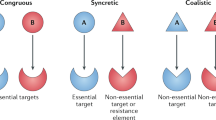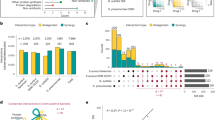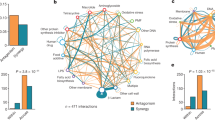Abstract
Combinations of antibiotics are commonly used in medicine to broaden antimicrobial spectrum and generate synergistic effects. Alternatively, combination of nonantibiotic drugs with antibiotics offers an opportunity to sample a previously untapped expanse of bioactive chemical space. We screened a collection of drugs to identify compounds that augment the activity of the antibiotic minocycline. Unexpected synergistic drug combinations exhibited in vitro and in vivo activity against bacterial pathogens, including multidrug–resistant isolates.


Similar content being viewed by others
References
Boucher, H.W. et al. Clin. Infect. Dis. 48, 1–12 (2009).
Parsons, A.B. et al. Nat. Biotechnol. 22, 62–69 (2004).
Costanzo, M. et al. Science 327, 425–431 (2010).
Sharom, J.R., Bellows, D.S. & Tyers, M. Curr. Opin. Chem. Biol. 8, 81–90 (2004).
Lehár, J. et al. Mol. Syst. Biol. 3, 80 (2007).
Walsh, C. Nature 406, 775–781 (2000).
Borisy, A.A. et al. Proc. Natl. Acad. Sci. USA 100, 7977–7982 (2003).
Chong, C.R. & Sullivan, D.J. Jr. Nature 448, 645–646 (2007).
Stolk, P., Willemen, M.J. & Leufkens, H.G. Bull. World Health Organ. 84, 745–751 (2006).
Kristiansen, J.E. et al. J. Antimicrob. Chemother. 59, 1271–1279 (2007).
Lehtinen, J. & Lilius, E.M. Int. J. Antimicrob. Agents 30, 44–51 (2007).
Mazumdar, K., Dastidar, S.G., Park, J.H. & Dutta, N.K. Eur. J. Clin. Microbiol. Infect. Dis. 28, 881–891 (2009).
Pillai, S.K., Moellering, R.C. & Eliopoulos, G.M. Antimicrobial combinations. in Antibiotics in Laboratory Medicine (Lorian, V., ed.) 365–440 (Williams and Wilkins, Baltimore, 2005).
Odds, F.C. J. Antimicrob. Chemother. 52, 1 (2003).
Christianson, S., Golding, G.R., Campbell, J. & Mulvey, M.R. J. Clin. Microbiol. 45, 1904–1911 (2007).
Kruszewska, H., Zareba, T. & Tyski, S. Acta Pol. Pharm. 61 Suppl: 18–21 (2004).
Barthel, M. et al. Infect. Immun. 71, 2839–2858 (2003).
Hurwitz, A., Sztern, M.I., Looney, G.A. & Ben-Zvi, Z. Life Sci. 54, 1687–1698 (1994).
Liu, A. et al. Antimicrob. Agents Chemother. 54, 1393–1403 (2010).
Taber, H.W., Mueller, J.P., Miller, P.F. & Arrow, A.S. Microbiol. Rev. 51, 439–457 (1987).
Cascales, E., Gavioli, M., Sturgis, J.N. & Lloubes, R. Mol. Microbiol. 38, 904–915 (2000).
Yamaguchi, A., Ohmori, H., Kaneko-Ohdera, M., Nomura, T. & Sawai, T. Antimicrob. Agents Chemother. 35, 53–56 (1991).
Paul, K., Erhardt, M., Hirano, T., Blair, D.F. & Hughes, K.T. Nature 451, 489–492 (2008).
Chopra, I. & Hacker, K. FEMS Microbiol. Lett. 51, 21–24 (1989).
Acknowledgements
The authors thank the staff of the McMaster High Throughput Screening Laboratory for technical assistance. The work was supported by Canada Research Chairs to E.D.B., M.T., G.D.W., the Canadian Cystic Fibrosis Foundation, Canadian Institutes of Health Research operating grants to E.D.B. (MOP-81330), G.D.W. (XNE-8705, FRN-79488) and the European Research Council to M.T.
Author information
Authors and Affiliations
Contributions
L.E. established screening conditions, ran the screens and determined synergy profiles for the compounds. J.W. prepared the PAD library, and M.A.F., L.E. and S.B.F. performed the mode-of-action studies on the loperamide-tetracycline pair. B.K.C. performed the mouse infectious studies. G.D.W., E.D.B., M.T. and B.K.C. wrote the manuscript. All authors discussed the results and commented on the manuscript.
Corresponding authors
Ethics declarations
Competing interests
The authors declare no competing financial interests.
Supplementary information
Supplementary Text and Figures
Supplementary Methods, Supplementary Results, Supplementary Tables 1–10, Supplementary Figures 1–6 and Supplementary Scheme 1 (PDF 4634 kb)
Rights and permissions
About this article
Cite this article
Ejim, L., Farha, M., Falconer, S. et al. Combinations of antibiotics and nonantibiotic drugs enhance antimicrobial efficacy. Nat Chem Biol 7, 348–350 (2011). https://doi.org/10.1038/nchembio.559
Received:
Accepted:
Published:
Issue Date:
DOI: https://doi.org/10.1038/nchembio.559
- Springer Nature America, Inc.
This article is cited by
-
Synergistic use of anti-inflammatory ketorolac and gentamicin to target staphylococcal biofilms
Journal of Translational Medicine (2024)
-
Synthetic peptide branched polymers for antibacterial and biomedical applications
Nature Reviews Bioengineering (2024)
-
Probiotic disruption of quorum sensing reduces virulence and increases cefoxitin sensitivity in methicillin-resistant Staphylococcus aureus
Scientific Reports (2023)
-
Systematic analysis of drug combinations against Gram-positive bacteria
Nature Microbiology (2023)
-
Toxicological assessment of Phormidium sp. derived copper oxide nanoparticles for its biomedical and environmental applications
Scientific Reports (2023)





